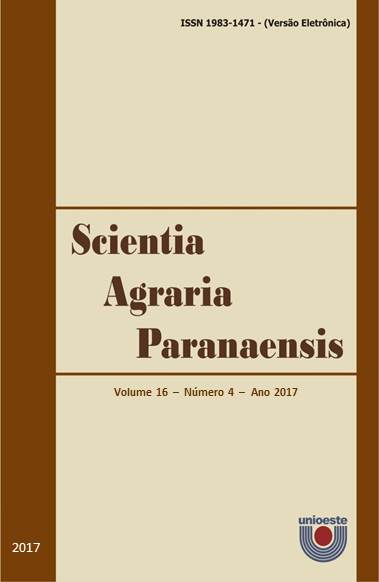Reaction of cotton genotypes to ramularia leaf spot (Ramularia areola Atk)
Palavras-chave:
Gossypium hirsutum L., Ramularia areola, resistência de cultivares.Resumo
Cotton cultivation is of great importance for Brazilian agribusiness, however, diseases such as the ramularia leaf spot cause serious damages to yield, therefore, it is sought to produce genotypes less susceptible to this disease. The objective of this study was to evaluate the productive performance of cotton genotypes and the resistance to ramularia leaf spot in two sowing times. A randomized complete block design was used, with 18 cotton genotypes and five replicates. The first sowing times was in December 2013 and the second times in January 2014, where the area under the disease progress curve (AUDPC), production and number of bolls were evaluated separately in each third of the plant, yield, index relative resistance and class of resistance of the genotypes of cotton to Ramularia areola. The genotype IMA 08-12427 showed lower AUDPC per plant, regardless of the sowing times. The genotypes TMG 82WS, BRS 371, DP 555BG RR, FM 982GL and BRS 372 obtained the highest yields in the first sowing times, ranging from 3,021.97 to 3,623.57 kg ha-1 of seed cotton and classified as moderately resistant (MR), MR, moderately susceptible (MS), susceptible (S) and MS, respectively. The first sowing times was more adequate for the study region, because the genotypes presented better performance in relation to the disease, having seven MR, six MS and five S, already in the second times were only three MR, four MS, ten S and one highly susceptible (AS).
Downloads
Publicado
Como Citar
Edição
Seção
Licença
Aviso de Direito Autoral Creative Commons
Política para Periódicos de Acesso Livre
Autores que publicam nesta revista concordam com os seguintes termos:
1. Autores mantém os direitos autorais e concedem à revista o direito de primeira publicação, com o trabalho simultaneamente licenciado sob a Licença Creative Commons Attribution que permite o compartilhamento do trabalho com reconhecimento da autoria e publicação inicial nesta revista.2. Autores têm autorização para assumir contratos adicionais separadamente, para distribuição não-exclusiva da versão do trabalho publicada nesta revista (ex.: publicar em repositório institucional ou como capítulo de livro), com reconhecimento de autoria e publicação inicial nesta revista.
3. Autores têm permissão e são estimulados a publicar e distribuir seu trabalho online (ex.: em repositórios institucionais ou na sua página pessoal) a qualquer ponto antes ou durante o processo editorial, já que isso pode gerar alterações produtivas, bem como aumentar o impacto e a citação do trabalho publicado (Veja O Efeito do Acesso Livre).
Licença Creative Commons
Esta obra está licenciada com uma Licença Creative Commons Atribuição-NãoComercial-CompartilhaIgual 4.0 Internacional, o que permite compartilhar, copiar, distribuir, exibir, reproduzir, a totalidade ou partes desde que não tenha objetivo comercial e sejam citados os autores e a fonte.


